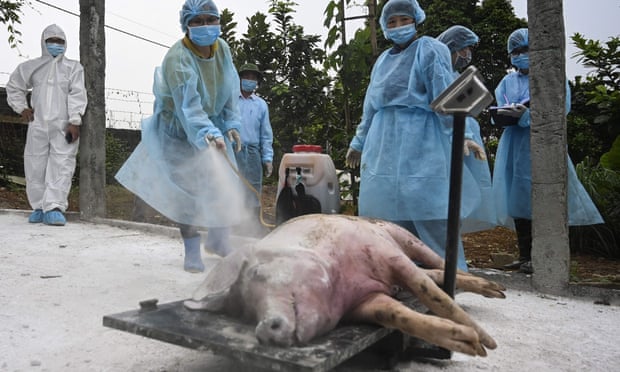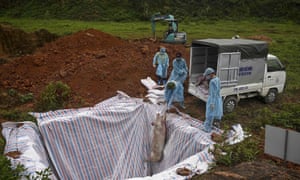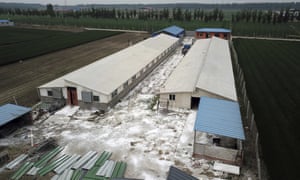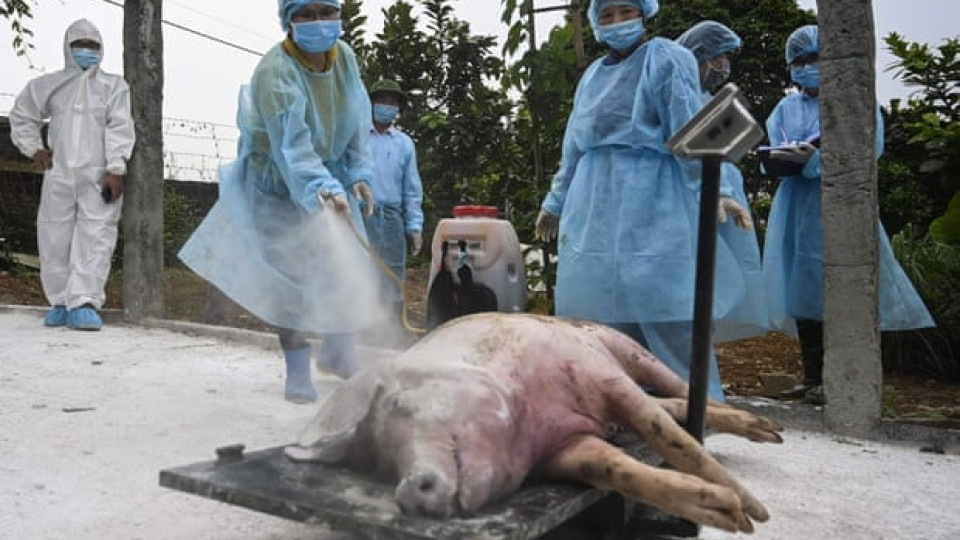
Experts say region is losing the battle to stop the biggest animal disease outbreak the planet has ever faced
South-east Asia is battling to contain the spread of highly contagious African swine fever, known as “pig Ebola”, which has already led to the culling of millions of pigs in China and Vietnam.
African swine fever, which is harmless to humans but fatal to pigs, was discovered in China in August, where it has caused havoc, leading to more than 1.2m pigs being culled. China is home to almost half of the world’s pigs and the news sent the global price of pork soaring.
There is no vaccination for African swine fever, which causes pigs to internally haemorrhage until they die, so the only option to contain the disease is to kill any contaminated animals. Some estimates say that in China up to 200m animals may eventually be slaughtered. The virus can last for several weeks on anything from clothes to vehicles, allowing for it to easily travel long distances.
It has spread like wildfire across Asia, causing growing devastation to the pig farmers of Vietnam and Cambodia and putting Thailand, Asia’s second-biggest pork producer, on “red alert”. Cases have increased in Mongolia, North Korea and Hong Kong in recent weeks, while South Korea is blood testing pigs at the border.
The UN Food and Agriculture organisation (UNFAO) and regional experts fear that Myanmar, Philippines and Laos will be next because they are all highly susceptible to an outbreak, due to the struggle to control the movement of pigs and pig products across porous borders.
“This is the biggest animal disease outbreak we’ve ever had on the planet,” said Dirk Pfeiffer, a veterinary epidemiologist at City University of Hong Kong and expert on African swine fever. “It makes the foot and mouth disease and BSE outbreaks pale in comparison to the damage that is being done. And we have no way to stop it from spreading.”

Health officials lower a pig carcass into an isolated quarantined pit in Hanoi. Photograph: Manan Vatsyayana/AFP/Getty Images
Currently the battle to contain the disease is being lost. “There are concerns that the disease will continue to spread across the countries in south-east Asia,” said Dr Wantanee Kalpravidh, regional manager for UNFAO, who said they believed the swine fever cases being reported by governments in the region were “underestimates”.
Wantanee said problems included the lack of compensation for pig farmers in south-east Asia whose herds were culled, giving them little reason to report a disease outbreak, and fears that banning movement of pigs and pork across borders would only create a “black market which would be impossible to control”.
The implications of the outbreak are already being felt beyond Asia. Global pork prices have risen by almost 40%, and long term it is likely to lead to more pork imports from Europe and America to meet demand, which will also push up global meat prices. Market analyst Rabobank said global pork supplies could fall by 8%.
In Vietnam, the first swine fever case was detected in January this year in northern Vietnam, not far from the border with China. Last week, agriculture minister Nguyen Xuan Cuong confirmed the virus had now spread to 48 of the country’s 63 provinces. The country has now culled about 2m pigs, or 6% of the country’s herd, a figure that is expected to rise steeply.
“The world and Vietnam have never faced such an extremely dangerous, difficult, complicated and expensive epidemic as this,” Cuong said in a statement last month.
The economic and social impact is likely to be huge for Vietnam. Pork accounts for 75% of all meat consumed in the country and it is an industry worth 94tn dong (£32m). Overall, the agriculture sector in Vietnam employs almost 50% of the workforce, with pork farming a significant part of that.
Speaking in parliament, Cuong urged consumers and businesses to stockpile pork ahead of likely shortages towards the end of the year. The government has also mobilised police and military to help contain the outbreak but has stopped short of declaring it a national emergency.
In Cambodia, around 2400 pigs have died or been culled due to the disease in the past two months, while in Hong Kong two separate cases led to there being no fresh pork in the country for a week.

White disinfectant powder is sprinkled on the soil around a pig farm in northern China’s Hebei province. Photograph: Sam McNeil/AP
But Pfeiffer was not optimistic Thailand – which has more than 2m pigs – could resist the pandemic spreading from neighbouring Vietnam and Cambodia, or China, for much longer, saying it could probably enter “through pork products brought in illegally from Vietnam and China, even if just by tourists or truck drivers”.
“The virus survives so well and there are so many people travelling particularly between China and Thailand, it’s hard to see how it could be contained for much longer,” he added.









Leave a comment